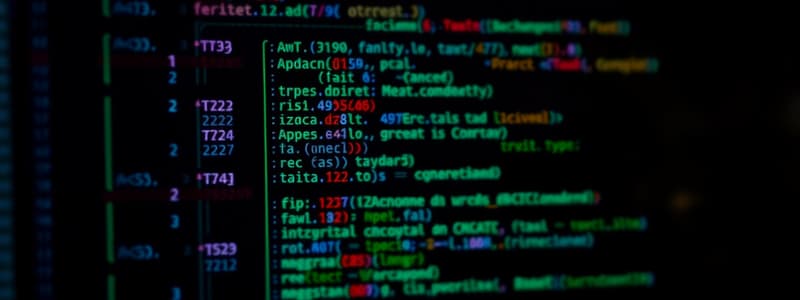Podcast
Questions and Answers
What is the range of values for the 'short' data type?
What is the range of values for the 'short' data type?
- -128 to 127
- -32,768 to 32,767 (correct)
- -2,147,483,648 to 2,147,483,647
- 0 to 4,294,967,295
Which of the following data types can hold a value of 250?
Which of the following data types can hold a value of 250?
- ushort (correct)
- sbyte
- float (correct)
- byte (correct)
What is the default value of the 'bool' data type?
What is the default value of the 'bool' data type?
- null
- true
- false (correct)
- 0
Which of the following data types is used to store 64-bit unsigned integers?
Which of the following data types is used to store 64-bit unsigned integers?
What is the maximum value of the 'int' data type?
What is the maximum value of the 'int' data type?
How does a reference type store data in memory?
How does a reference type store data in memory?
The data type that can represent a single Unicode character is?
The data type that can represent a single Unicode character is?
Which data type has the range from 1.5E-45 to 3.4E+38?
Which data type has the range from 1.5E-45 to 3.4E+38?
Which data type can be explicitly converted to a char data type?
Which data type can be explicitly converted to a char data type?
What will be the value of 'b' if 'int a = 64; char b = (char) a;' is executed?
What will be the value of 'b' if 'int a = 64; char b = (char) a;' is executed?
Which of the following types can be converted to an ulong?
Which of the following types can be converted to an ulong?
What is type conversion commonly used for in programming?
What is type conversion commonly used for in programming?
Which pair of data types cannot explicitly convert to each other?
Which pair of data types cannot explicitly convert to each other?
Which of the following is an example of implicit conversion?
Which of the following is an example of implicit conversion?
Which data types can be converted to an int?
Which data types can be converted to an int?
Which of these data types can be converted to float?
Which of these data types can be converted to float?
What happens when a variable of type int is converted to type double?
What happens when a variable of type int is converted to type double?
Which data type can char be implicitly converted to?
Which data type can char be implicitly converted to?
What is the type conversion direction possible for the 'ushort' data type?
What is the type conversion direction possible for the 'ushort' data type?
Which data type explicitly converts to byte?
Which data type explicitly converts to byte?
Which of the following statements about implicit conversion is true?
Which of the following statements about implicit conversion is true?
Which conversion does not produce a valid implicit conversion based on the content?
Which conversion does not produce a valid implicit conversion based on the content?
What is the maximum value that a byte can hold?
What is the maximum value that a byte can hold?
Which statement correctly describes the implicit conversion of a ulong to a float?
Which statement correctly describes the implicit conversion of a ulong to a float?
In which situation is implicit conversion not permitted?
In which situation is implicit conversion not permitted?
What is commonly accepted as the precision order of numeric data types in C#?
What is commonly accepted as the precision order of numeric data types in C#?
What will be printed if the exam_score is set to 85?
What will be printed if the exam_score is set to 85?
In an if-else-if statement, when does the control skip the subsequent conditions?
In an if-else-if statement, when does the control skip the subsequent conditions?
What is the minimum value for exam_score to receive an F?
What is the minimum value for exam_score to receive an F?
Which types of variables can be used in a switch statement in C#?
Which types of variables can be used in a switch statement in C#?
In the following code, which condition evaluates to true? if (exam_score < 95 && exam_score > 50)
In the following code, which condition evaluates to true? if (exam_score < 95 && exam_score > 50)
What would be the output if exam_score is set to 45?
What would be the output if exam_score is set to 45?
What is the purpose of the 'break' statement in a switch case?
What is the purpose of the 'break' statement in a switch case?
If exam_score is set to 100, which block of code will be executed in this scenario?
If exam_score is set to 100, which block of code will be executed in this scenario?
What is the correct syntax of the ternary operator?
What is the correct syntax of the ternary operator?
What will be the value of the variable 'sum' after executing the line 'int sum = 4 > 2 ? 4 + 2 : 4 - 2;'?
What will be the value of the variable 'sum' after executing the line 'int sum = 4 > 2 ? 4 + 2 : 4 - 2;'?
In the expression 'int exam_score = 75; string result = exam_score >= 60 ? "Student passed the exam." : "Student failed the exam.";', what is the value of 'result'?
In the expression 'int exam_score = 75; string result = exam_score >= 60 ? "Student passed the exam." : "Student failed the exam.";', what is the value of 'result'?
What type of statements are allowed in the consequence and alternative sections of the ternary operator?
What type of statements are allowed in the consequence and alternative sections of the ternary operator?
Which of the following best describes the purpose of the ternary operator?
Which of the following best describes the purpose of the ternary operator?
Which C# looping structure first evaluates the condition before executing the loop body?
Which C# looping structure first evaluates the condition before executing the loop body?
What would happen if the condition in a ternary operator evaluates to false?
What would happen if the condition in a ternary operator evaluates to false?
What is a key feature of the ternary operator regarding its return value?
What is a key feature of the ternary operator regarding its return value?
Flashcards are hidden until you start studying
Study Notes
Data Types in C#
- Value Types: Store actual data values directly; includes integers, floating-point numbers, Boolean, and characters.
- sbyte: 8-bit signed integer, range -128 to 127, default value 0.
- short: 16-bit signed integer, range -32,768 to 32,767, default value 0.
- int: 32-bit signed integer, range -2,147,483,648 to 2,147,483,647, default value 0.
- long: 64-bit signed integer, range -263 to 263-1, default value 0L.
- byte: 8-bit unsigned integer, range 0 to 255, default value 0.
- ushort: 16-bit unsigned integer, range 0 to 65,535, default value 0.
- uint: 32-bit unsigned integer, range 0 to 4,294,967,295, default value 0.
- ulong: 64-bit unsigned integer, range 0 to 264-1, default value 0.
- float: Single-precision 32-bit floating-point number, range 1.5E-45 to 3.4E+38, default value 0.0F.
- double: Double-precision 64-bit floating-point number, range 5E-324 to 1.7E+308, default value 0.0D.
- bool: 8-bit logical Boolean type, can be either true or false, default value is false.
- char: 16-bit Unicode character, range from '\u0000' to '\uffff', default value '\0'.
Reference Types
- Store the address of the value rather than the value itself.
- Include strings, objects, arrays, and delegates.
- Example for a reference type: variable
strNameholds the memory address where the value "Jess Diaz" is stored.
Type Conversion
- Type conversion: Process of converting a value from one data type to another.
- Implicit Conversion: Automatic conversion from a lower precision type to a higher precision type; e.g.,
shorttoint. - Examples of compatible implicit conversions include:
sbytetoshort,int,long,float, ordoublebytetoshort,ushort,int,uint,long,ulong,float, ordoublechartoushort,int,uint,long,ulong,float, ordouble
Conversion Examples
- Explicit conversion example:
int a = 64; char b = (char) a;results inbbeing@. - Make sure conversions retain types that are compatible.
Operators and Expressions
- Operators perform specific mathematical or logical operations within programming.
- Conditionals: Control flow statements that execute based on conditions.
- if-else-if statement: Executes conditions top to bottom; if a condition is true, subsequent conditions are skipped.
- switch statement: Allows execution of code blocks based on matching the value of a variable against predefined values.
- Ternary operator: Provides a shorthand for conditional statements, syntax:
condition ? consequence : alternative.
Looping Constructs
- Loops: Allow repeated execution of a block of statements until a condition evaluates to false.
- while loop: Executes statements while a specified condition is true; evaluates the condition before running the loop body.
Studying That Suits You
Use AI to generate personalized quizzes and flashcards to suit your learning preferences.





